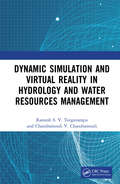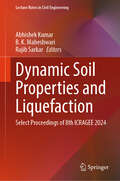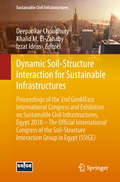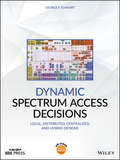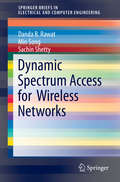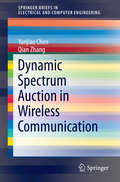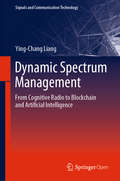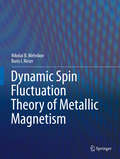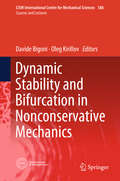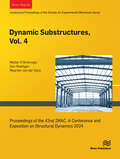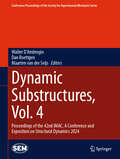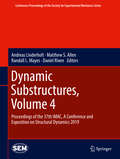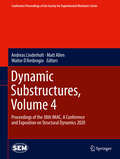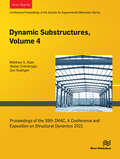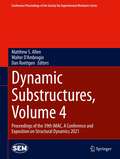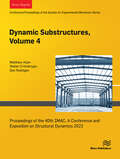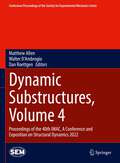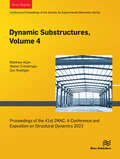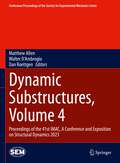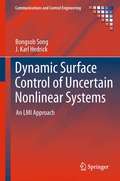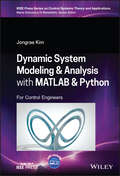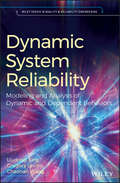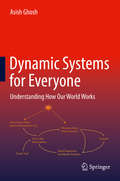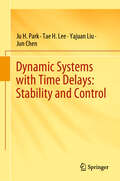- Table View
- List View
Dynamic Simulation and Virtual Reality in Hydrology and Water Resources Management
by Ramesh S.V. Teegavarapu Chandramouli V. ChandramouliDynamic Simulation and Virtual Reality in Hydrology and Water Resources Management focuses on the understanding, use, and application of system dynamics simulation and virtual reality approaches for modeling the spatial and temporal behavior of natural and managed hydro-environmental systems. The book discusses concepts of systems thinking and system dynamics approach, and it furthers understanding of the dynamic behavior of natural and engineering systems using feedbacks and dynamic simulation. Numerous examples of models built using different system dynamics simulation modeling environments are provided. It also introduces concepts related to computer animation and virtual reality–based immersive modeling. Applications of systems dynamics, simulation with animation, and virtual reality approaches for modeling and management of hydro-environmental systems are illustrated through case studies. This text is ideal for water resources professionals, graduate students, hydrologic modelers, and engineers who are interested in systems thinking, dynamic simulation, and virtual reality modeling approaches. It will serve as a valuable reference for engineering professionals who model, manage, and operate hydrosystems. Engineering educators will find the book immensely useful to enhance the learning experiences of students. Dr. Ramesh S. V. Teegavarapu is a professor at Florida Atlantic University with expertise in modeling water resources and environmental systems, hydroinformatics, and climate change. Dr. Chandramouli V. Chandramouli is a professor at Purdue University Northwest. His expertise is in water resources and environmental modeling integrating artificial intelligence techniques.
Dynamic Simulation of Sodium Cooled Fast Reactors
by G VaidyanathanThis book provides the basis of simulating a nuclear plant, in understanding the knowledge of how such simulations help in assuring the safety of the plants, thereby protecting the public from accidents. It provides the reader with an in-depth knowledge about modeling the thermal and flow processes in a fast reactor and gives an idea about the different numerical solution methods. The text highlights the application of the simulation to typical sodium-cooled fast reactor. The book • Discusses mathematical modeling of the heat transfer process in a fast reactor cooled by sodium. • Compares different numerical techniques and brings out the best one for the solution of the models. • Provides a methodology of validation based on experiments. • Examines modeling and simulation aspects necessary for the safe design of a fast reactor. • Emphasizes plant dynamics aspects, which is important for relating the interaction between the components in the heat transport systems. • Discusses the application of the models to the design of a sodium-cooled fast reactor It will serve as an ideal reference text for senior undergraduate, graduate students, and academic researchers in the fields of nuclear engineering, mechanical engineering, and power cycle engineering.
Dynamic Soil Properties and Liquefaction: Select Proceedings of 8th ICRAGEE 2024 (Lecture Notes in Civil Engineering #569)
by Abhishek Kumar Rajib Sarkar B. K. MaheshwariThis book will present the select proceedings of the 8th International Conference on Recent Advances in Geotechnical Earthquake Engineering and Soil Dynamics (8ICRAGEE) held at the Indian Institute of Technology (IIT), Guwahati between December 11 and 14, 2024. It contains the latest research papers covering the contributions and accomplishments in geotechnical earthquake engineering and soil dynamics in the last four years. The five volumes of the book cover a wide range of topics, including but not limited to seismic hazard analysis, wave propagation and site characterization, dynamic properties and liquefaction of soils, pile foundations, offshore foundations, seismic design of retaining structures and dams, seismic slope stability and landslides, dynamic soil-structure interaction, seismic design of structures. Further, recent developments on these topics are covered in different chapters. This book will be valuable not only for researchers and professionals but also for drawing an agenda for future courses of action from the perspective of geotechnical earthquake engineering, keeping the national need at the forefront.This book will present the select proceedings of the 8th International Conference on Recent Advances in Geotechnical Earthquake Engineering and Soil Dynamics (8ICRAGEE) held at the Indian Institute of Technology (IIT), Guwahati between December 11 and 14, 2024. It contains the latest research papers covering the contributions and accomplishments in geotechnical earthquake engineering and soil dynamics in the last four years. The five volumes of the book cover a wide range of topics, including but not limited to seismic hazard analysis, wave propagation and site characterization, dynamic properties and liquefaction of soils, pile foundations, offshore foundations, seismic design of retaining structures and dams, seismic slope stability and landslides, dynamic soil-structure interaction, seismic design of structures. Further, recent developments on these topics are covered in different chapters. This book will be valuable not only for researchers and professionals but also for drawing an agenda for future courses of action from the perspective of geotechnical earthquake engineering, keeping the national need at the forefront.
Dynamic Soil-Structure Interaction for Sustainable Infrastructures: Proceedings of the 2nd GeoMEast International Congress and Exhibition on Sustainable Civil Infrastructures, Egypt 2018 – The Official International Congress of the Soil-Structure Interaction Group in Egypt (SSIGE) (Sustainable Civil Infrastructures)
by Deepankar Choudhury Khalid M. El-Zahaby Izzat IdrissThis volume focuses on the role of soil-structure-interaction and soil dynamics. It discusses case studies as well as physical and numerical models of geo-structures. It covers: Soil-Structure-Interaction under static and dynamic loads, dynamic behavior of soils, and soil liquefaction. It is hoped that this volume will contribute to further advance the state-of-the-art for the next generation infrastructure as a key to creating a sustainable community affecting our future well-being as well as the economic climate. The volume is based on the best contributions to the 2nd GeoMEast International Congress and Exhibition on Sustainable Civil Infrastructures, Egypt 2018 – The official international congress of the Soil-Structure Interaction Group in Egypt (SSIGE).
Dynamic Spectrum Access Decisions: Local, Distributed, Centralized, and Hybrid Designs (Wiley - IEEE)
by George F. ElmasryOptimize your dynamic spectrum access approach using the latest applications and techniques Dynamic Spectrum Access Decisions: Local, Distributed, Centralized and Hybrid Designs prepares engineers to build optimum communications systems by describing at the outset what type of spectrum sensing capabilities are needed. Meant for anyone who has a basic understanding of wireless communications and networks and an interest in the physical and MAC layers of communication systems, this book has a tremendous range of civilian and military applications. Dynamic Spectrum Access Decisions provides fulsome discussions of cognitive radios and networks, but also DSA technologies that operate outside the context of cognitive radios. DSA has applications in: · Licensed spectrum bands · Unlicensed spectrum bands · Civilian communications · Military communications Consisting of a set of techniques derived from network information theory and game theory, DSA improves the performance of communications networks. This book addresses advanced topics in this area and assumes basic knowledge of wireless communications.
Dynamic Spectrum Access for Wireless Networks
by Sachin Shetty Min Song Danda B. RawatThis SpringerBrief presents adaptive resource allocation schemes for secondary users for dynamic spectrum access (DSA) in cognitive radio networks (CRNs) by considering Quality-of-Service requirements, admission control, power/rate control, interference constraints, and the impact of spectrum sensing or primary user interruptions. It presents the challenges, motivations, and applications of the different schemes. The authors discuss cloud-assisted geolocation-aware adaptive resource allocation in CRNs by outsourcing computationally intensive processing to the cloud. Game theoretic approaches are presented to solve resource allocation problems in CRNs. Numerical results are presented to evaluate the performance of the proposed methods. Adaptive Resource Allocation in Cognitive Radio Networks is designed for professionals and researchers working in the area of wireless networks. Advanced-level students in electrical engineering and computer science, especially those focused on wireless networks, will find this information helpful.
Dynamic Spectrum Auction in Wireless Communication
by Yanjiao Chen Qian ZhangThis brief explores current research on dynamic spectrum auctions, focusing on fundamental auction theory, characteristics of the spectrum market, spectrum auction architecture and possible auction mechanisms. The brief explains how dynamic spectrum auctions, which enable new users to gain spectrum access and existing spectrum owners to obtain financial benefits, can greatly improve spectrum efficiency by resolving the artificial spectrum shortage. It examines why operators and users face significant challenges due to specialty of the spectrum market and the related requirements imposed on the auction mechanism design. Concise and up-to-date, Dynamic Spectrum Auction in Wireless Communication is designed for researchers and professionals in computer science or electrical engineering. Students studying networking will also find this brief a valuable resource.
Dynamic Spectrum Management: From Cognitive Radio to Blockchain and Artificial Intelligence (Signals and Communication Technology)
by Ying-Chang LiangThis open access book, authored by a world-leading researcher in this field, describes fundamentals of dynamic spectrum management, provides a systematic overview on the enabling technologies covering cognitive radio, blockchain, and artificial intelligence, and offers valuable guidance for designing advanced wireless communications systems. This book is intended for a broad range of readers, including students and professionals in this field, as well as radio spectrum policy makers.
Dynamic Spin-Fluctuation Theory of Metallic Magnetism
by Nikolai B. Melnikov Boris I. ReserThis book presents a theoretical framework for magnetism in ferromagnetic metals and alloys at finite temperatures. The objective of the book is twofold. First, it gives a detailed presentation of the dynamic spin-fluctuation theory that takes into account both local and long-wave spin fluctuations with any frequency. The authors provide a detailed explanation of the fundamental role of quantum spin fluctuations in the mechanism of metallic magnetism and illustrate the theory with concrete examples. The second objective of the book is to give an accurate and self-contained presentation of many-body techniques such as the functional integral method and Green's functions, via a number of worked examples. These computational methods are of great use to solid state physicists working in a range of specialties.The book is intended primarily for researchers, but can also be used as textbook. The introductory chapters offer clear and complete derivations of the fundamentals, which makes the presentation self-contained. The main text is followed by a number of well-organized appendices that contain a detailed presentation of the necessary many-body techniques and computational methods. The book also includes a list of symbols and detailed index. This volume will be of interest to a wide range of physicists interested in magnetism and solid state physics in general, both theoreticians and experimentalists.
Dynamic Stability and Bifurcation in Nonconservative Mechanics (CISM International Centre for Mechanical Sciences #586)
by Davide Bigoni Oleg KirillovThe book offers a unified view on classical results and recent advances in the dynamics of nonconservative systems. The theoretical fundamentals are presented systematically and include: Lagrangian and Hamiltonian formalism, non-holonomic constraints, Lyapunov stability theory, Krein theory of spectra of Hamiltonian systems and modes of negative and positive energy, anomalous Doppler effect, reversible systems, sensitivity analysis of non-self-adjoint operators, dissipation-induced instabilities, local and global instabilities. They are applied to engineering situations such as the coupled mode flutter of wings, flags and pipes, flutter in granular materials, piezoelectric mechanical metamaterials, wave dynamics of infinitely long structures, radiative damping, stability of high-speed trains, experimental realization of follower forces, soft-robot locomotion, wave energy converters, friction-induced instabilities, brake squeal, non-holonomic sailing, dynamics of moving continua, and stability of bicycles and walking robots. The book responds to a demand in the modern theory of nonconservative systems coming from the growing number of scientific and engineering disciplines including physics, fluid and solids mechanics, fluid-structure interactions, and modern multidisciplinary research areas such as biomechanics, micro- and nanomechanics, optomechanics, robotics, and material science. It is targeted at both young and experienced researchers and engineers working in fields associated with the dynamics of structures and materials. The book will help to get a comprehensive and systematic knowledge on the stability, bifurcations and dynamics of nonconservative systems and establish links between approaches and methods developed in different areas of mechanics and physics and modern applied mathematics.
Dynamic Substructures, Vol. 4: Proceedings of the 42nd IMAC, A Conference and Exposition on Structural Dynamics 2024
by Walter D'Ambrogio Dan Roettgen van der Seijs, MaartenDynamics of Coupled Structures, Volume 4: Proceedings of the 42nd IMAC, A Conference and Exposition on Structural Dynamics, 2024, the fourth volume of ten from the Conference brings together contributions to this important area of research and engineering. The collection presents early findings and case studies on fundamental and applied aspects of the Dynamics of Coupled Structures, including papers on: Linear Joints, Nonlinear Joints and Coupling Modal and Frequency Based Substructuring Round Robin Test Bed on Dynamic Substructuring Transfer Path Analysis and Force Estimation Interface Dynamics.
Dynamic Substructures, Vol. 4: Proceedings of the 42nd IMAC, A Conference and Exposition on Structural Dynamics 2024 (Conference Proceedings of the Society for Experimental Mechanics Series)
by Walter D’Ambrogio Dan Roettgen Maarten van der SeijsDynamics of Coupled Structures, Volume 4: Proceedings of the 42nd IMAC, A Conference and Exposition on Structural Dynamics, 2024, the fourth volume of ten from the Conference brings together contributions to this important area of research and engineering. The collection presents early findings and case studies on fundamental and applied aspects of the Dynamics of Coupled Structures, including papers on: Linear Joints, Nonlinear Joints and Coupling Modal and Frequency Based Substructuring Round Robin Test Bed on Dynamic Substructuring Transfer Path Analysis and Force Estimation Interface Dynamics
Dynamic Substructures, Volume 4: Proceedings of the 37th IMAC, A Conference and Exposition on Structural Dynamics 2019 (Conference Proceedings of the Society for Experimental Mechanics Series)
by Randall L. Mayes Daniel Rixen Matthew S. Allen Andreas LinderholtDynamics of Coupled Structures, Volume 4: Proceedings of the 37th IMAC, A Conference and Exposition on Structural Dynamics, 2019, the fourth volume of eight from the Conference brings together contributions to this important area of research and engineering. The collection presents early findings and case studies on fundamental and applied aspects of the Dynamics of Coupled Structures, including papers on: Methods for Dynamic Substructures Applications for Dynamic SubstructuresInterfaces & SubstructuringFrequency Based Substructuring Transfer Path Analysis
Dynamic Substructures, Volume 4: Proceedings of the 38th IMAC, A Conference and Exposition on Structural Dynamics 2020 (Conference Proceedings of the Society for Experimental Mechanics Series)
by Matt Allen Andreas Linderholt Walter D’AmbrogioDynamics of Coupled Structures, Volume 4: Proceedings of the 38th IMAC, A Conference and Exposition on Structural Dynamics, 2020, the fourth volume of eight from the Conference brings together contributions to this important area of research and engineering. The collection presents early findings and case studies on fundamental and applied aspects of the Dynamics of Coupled Structures, including papers on:Methods for Dynamic Substructures Applications for Dynamic SubstructuresInterfaces & SubstructuringFrequency Based Substructuring Transfer Path Analysis
Dynamic Substructures, Volume 4: Proceedings of the 39th IMAC, A Conference and Exposition on Structural Dynamics 2021
by Matthew S. Allen Walter D’Ambrogio Dan RoettgenDynamic Substructures, Volume 4: Proceedings of the 39th IMAC, A Conference and Exposition on Structural Dynamics, 2021, the fourth volume of nine from the Conference brings together contributions to this important area of research and engineering. The collection presents early findings and case studies on fundamental and applied aspects of the Dynamics of Coupled Structures, including papers on: Methods for Dynamic Substructures Applications for Dynamic Substructures Interfaces & Substructuring Frequency Based Substructuring Transfer Path Analysis.
Dynamic Substructures, Volume 4: Proceedings of the 39th IMAC, A Conference and Exposition on Structural Dynamics 2021 (Conference Proceedings of the Society for Experimental Mechanics Series)
by Matthew S. Allen Walter D’Ambrogio Dan RoettgenDynamic Substructures, Volume 4: Proceedings of the 39th IMAC, A Conference and Exposition on Structural Dynamics, 2021, the fourth volume of nine from the Conference brings together contributions to this important area of research and engineering. The collection presents early findings and case studies on fundamental and applied aspects of the Dynamics of Coupled Structures, including papers on:Methods for Dynamic Substructures Applications for Dynamic SubstructuresInterfaces & SubstructuringFrequency Based Substructuring Transfer Path Analysis
Dynamic Substructures, Volume 4: Proceedings of the 40th IMAC, A Conference and Exposition on Structural Dynamics 2022
by Matthew Allen Walter D’Ambrogio Dan RoettgenDynamics of Coupled Structures, Volume 4: Proceedings of the 40th IMAC, A Conference and Exposition on Structural Dynamics, 2022, the fourth volume of nine from the Conference brings together contributions to this important area of research and engineering. The collection presents early findings and case studies on fundamental and applied aspects of the Dynamics of Coupled Structures, including papers on: Transfer Path Analysis Blocked Forces and Experimental Techniques Real-Time Hybrid Substructuring and Uncertainty Quantification in Substructuring Nonlinear Substructuring.
Dynamic Substructures, Volume 4: Proceedings of the 40th IMAC, A Conference and Exposition on Structural Dynamics 2022 (Conference Proceedings of the Society for Experimental Mechanics Series)
by Matthew Allen Walter D’Ambrogio Dan RoettgenDynamics of Coupled Structures, Volume 4: Proceedings of the 40th IMAC, A Conference and Exposition on Structural Dynamics, 2022, the fourth volume of nine from the Conference brings together contributions to this important area of research and engineering. The collection presents early findings and case studies on fundamental and applied aspects of the Dynamics of Coupled Structures, including papers on:Transfer Path AnalysisBlocked Forces and Experimental TechniquesReal-Time Hybrid Substructuring and Uncertainty Quantification in SubstructuringNonlinear Substructuring
Dynamic Substructures, Volume 4: Proceedings of the 41st IMAC, A Conference and Exposition on Structural Dynamics 2023
by Matthew Allen Walter D’Ambrogio Dan RoettgenDynamics of Coupled Structures, Volume 4: Proceedings of the 41st IMAC, A Conference and Exposition on Structural Dynamics, 2023, the fourth volume of ten from the Conference brings together contributions to this important area of research and engineering. The collection presents early findings and case studies on fundamental and applied aspects of the Dynamics of Coupled Structures, including papers on: Real-Time/Hybrid Substructuring Transfer Path Analysis Frequency Based Substructuring The Substructuring Benchmark Challenge New Challenges & Approaches in Substructuring.
Dynamic Substructures, Volume 4: Proceedings of the 41st IMAC, A Conference and Exposition on Structural Dynamics 2023 (Conference Proceedings of the Society for Experimental Mechanics Series)
by Matthew Allen Walter D’Ambrogio Dan RoettgenDynamics of Coupled Structures, Volume 4: Proceedings of the 41st IMAC, A Conference and Exposition on Structural Dynamics, 2023, the fourth volume of ten from the Conference brings together contributions to this important area of research and engineering. The collection presents early findings and case studies on fundamental and applied aspects of the Dynamics of Coupled Structures, including papers on: Real-Time/Hybrid Substructuring Transfer Path Analysis Frequency Based Substructuring The Substructuring Benchmark Challenge New Challenges & Approaches in Substructuring
Dynamic Surface Control of Uncertain Nonlinear Systems
by Bongsob Song J. Karl HedrickAlthough the problem of nonlinear controller design is as old as that of linear controller design, the systematic design methods framed in response are more sparse. Given the range and complexity of nonlinear systems, effective new methods of control design are therefore of significant importance. Dynamic Surface Control of Uncertain Nonlinear Systems provides a theoretically rigorous and practical introduction to nonlinear control design. The convex optimization approach applied to good effect in linear systems is extended to the nonlinear case using the new dynamic surface control (DSC) algorithm developed by the authors. A variety of problems - DSC design, output feedback, input saturation and fault-tolerant control among them - are considered. The inclusion of applications material demonstrates the real significance of the DSC algorithm, which is robust and easy to use, for nonlinear systems with uncertainty in automotive and robotics. Written for the researcher and graduate student of nonlinear control theory, this book will provide the applied mathematician and engineer alike with a set of powerful tools for nonlinear control design. It will also be of interest to practitioners working with a mechatronic systems in aerospace, manufacturing and automotive and robotics, milieux.
Dynamic System Modelling and Analysis with MATLAB and Python: For Control Engineers (IEEE Press Series on Control Systems Theory and Applications)
by Jongrae KimDynamic System Modeling & Analysis with MATLAB & Python A robust introduction to the advanced programming techniques and skills needed for control engineering In Dynamic System Modeling & Analysis with MATLAB & Python: For Control Engineers, accomplished control engineer Dr. Jongrae Kim delivers an insightful and concise introduction to the advanced programming skills required by control engineers. The book discusses dynamic systems used by satellites, aircraft, autonomous robots, and biomolecular networks. Throughout the text, MATLAB and Python are used to consider various dynamic modeling theories and examples. The author covers a range of control topics, including attitude dynamics, attitude kinematics, autonomous vehicles, systems biology, optimal estimation, robustness analysis, and stochastic system. An accompanying website includes a solutions manual as well as MATLAB and Python example code. Dynamic System Modeling & Analysis with MATLAB & Python: For Control Engineers provides readers with a sound starting point to learning programming in the engineering or biology domains. It also offers: A thorough introduction to attitude estimation and control, including attitude kinematics and sensors and extended Kalman filters for attitude estimation Practical discussions of autonomous vehicles mission planning, including unmanned aerial vehicle path planning and moving target tracking Comprehensive explorations of biological network modeling, including bio-molecular networks and stochastic modeling In-depth examinations of control algorithms using biomolecular networks, including implementation Dynamic System Modeling & Analysis with MATLAB & Python: For Control Engineers is an indispensable resource for advanced undergraduate and graduate students seeking practical programming instruction for dynamic system modeling and analysis using control theory.
Dynamic System Reliability: Modeling and Analysis of Dynamic and Dependent Behaviors (Quality and Reliability Engineering Series)
by Liudong Xing Gregory Levitin Chaonan WangOffers timely and comprehensive coverage of dynamic system reliability theory This book focuses on hot issues of dynamic system reliability, systematically introducing the reliability modeling and analysis methods for systems with imperfect fault coverage, systems with function dependence, systems subject to deterministic or probabilistic common-cause failures, systems subject to deterministic or probabilistic competing failures, and dynamic standby sparing systems. It presents recent developments of such extensions involving reliability modelling theory, reliability evaluation methods, and features numerous case studies based on real-world examples. The presented dynamic reliability theory can enable a more accurate representation of actual complex system behavior, thus more effectively guiding the reliable design of real-world critical systems. Dynamic System Reliability: Modelling and Analysis of Dynamic and Dependent Behaviors begins by describing the evolution from the traditional static reliability theory to the dynamic system reliability theory, and provides a detailed investigation of dynamic and dependent behaviors in subsequent chapters. Although written for those with a background in basic probability theory and stochastic processes, the book includes a chapter reviewing the fundamentals that readers need to know in order to understand contents of other chapters which cover advanced topics in reliability theory and case studies. The first book systematically focusing on dynamic system reliability modelling and analysis theory Provides a comprehensive treatment on imperfect fault coverage (single-level/multi-level or modular), function dependence, common cause failures (deterministic and probabilistic), competing failures (deterministic and probabilistic), and dynamic standby sparing Includes abundant illustrative examples and case studies based on real-world systems Covers recent advances in combinatorial models and algorithms for dynamic system reliability analysis Offers a rich set of references, providing helpful resources for readers to pursue further research and study of the topics Dynamic System Reliability: Modelling and Analysis of Dynamic and Dependent Behaviors is an excellent book for undergraduate and graduate students, and engineers and researchers in reliability and related disciplines.
Dynamic Systems for Everyone: Understanding How Our World Works
by Asish GhoshSystems are everywhere and we are surrounded by them. We are a complex amalgam of systems that enable us to interact with an endless array of external systems in our daily lives. They are electrical, mechanical, social, biological, and many other types that control our environment and our well-being. By appreciating how these systems function, will broaden our understanding of how our world works. Readers from a variety of disciplines will benefit from the knowledge of system behavior they will gain from this book and will be able to apply those principles in various contexts. The treatment of the subject is non-mathematical, and the book considers some of the latest concepts in the systems discipline, such as agent based systems, optimization, and discrete events and procedures. The diverse range of examples provided in this book, will allow readers to:Apply system knowledge at work and in daily life without deep mathematical knowledge;Build models and simulate system behaviors on a personal computer; Optimize systems in many different ways;Reduce or eliminate unintended consequences;Develop a holistic world view .This book will enable readers to not only better interact with the systems in their professional and daily lives, but also allow them to develop and evaluate them for their effectiveness in achieving their designed purpose.Comments from Reviewers: “This is a marvelously well written introduction to Systems Thinking and System Dynamics - I like it because it introduces Systems Thinking with meaningful examples, which everyone should be able to readily connect” - Gene Bellinger, Organizational theorist, systems thinker, and consultant, Director Systems Thinking World “Excellent book ...very well written. Mr. Ghosh's world view of system thinking is truly unique” - Peter A. Rizzi, Professor Emeritus, University of Massachusetts Dartmouth “A thorough reading of the book provides an interesting way to view many problems in our society” –Bradford T. Stokes, Poppleton Chair and Professor Emeritus, The Ohio State University College of Medicine “This is a very good and very readable book that is a must read for any person involved in systems theory in any way - which may actually include just about everyone” - Peter G. Martin, Vice President Business Value Consulting, Schneider Electric
Dynamic Systems with Time Delays: Stability And Control
by Jun Chen Ju H. Park Tae H. Lee Yajuan LiuThis book presents up-to-date research developments and novel methodologies to solve various stability and control problems of dynamic systems with time delays. First, it provides the new introduction of integral and summation inequalities for stability analysis of nominal time-delay systems in continuous and discrete time domain, and presents corresponding stability conditions for the nominal system and an applicable nonlinear system. Next, it investigates several control problems for dynamic systems with delays including H(infinity) control problemEvent-triggered control problems; Dynamic output feedback control problems; Reliable sampled-data control problems. Finally, some application topics covering filtering, state estimation, and synchronization are considered. The book will be a valuable resource and guide for graduate students, scientists, and engineers in the system sciences and control communities.
